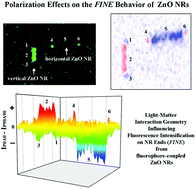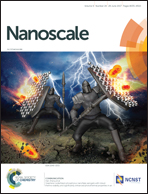Polarization-resolved mechanistic investigation of fluorescence signal intensification on zinc oxide nanorod ends
Abstract
The superior optical properties of zinc oxide nanorods (ZnO NRs) have continued to promote their broad use in photonic, photoelectric, light detecting, and biosensing applications. One particularly important property pertinent to biodetection is fluorescence intensification on nanorod ends (FINE), a phenomenon in which a highly spatially localized and strongly intensified fluorescence signal with its extended photostability at the NR ends is seen from the emission profiles of fluorophore-coupled biomolecules on ZnO NRs. Therefore, understanding key parameters affecting the FINE phenomenon and the degree of FINE (DoF) is critical for their applications in biosensors. In this study, we describe in detail the outcomes of polarization-resolved measurements by systematically considering the polarization effects on FINE and DoF as a function of NR tilt angle and position along the NR. Specifically, we elucidate the exact roles of the different states of light polarization in FINE and quantitatively determine the explicit contributions arising from distinctive polarization states to the DoF. We confirm that the presence of the FINE phenomenon is ubiquitous from the fluorophore-coupled ZnO NR systems, regardless of the polarization setting. We subsequently show that DoF is significantly affected by the light–matter interaction geometry. We reveal the specific polarization conditions that contribute dominantly to the FINE effect. The highest DoF from a NR and the greatest NR end intensity can be achieved when both the excitation and collection polarization states are perpendicular to the NR main axis. Insights from this study provide valuable design principles for selecting the polarization state and light–matter interaction geometry to attain maximum FINE as well as DoF on ZnO NRs. The precise understanding of polarization-derived consequences on FINE and DoF manifested differently as a function of the position on individual NRs can also be important for warranting accurate interpretation and quantification of the position-dependent, fluorophore-emitted signals on single ZnO NRs. Hence, our findings from this study can be extremely beneficial in fluorescence-based sensing and detection settings utilizing polarization.



 Please wait while we load your content...
Please wait while we load your content...